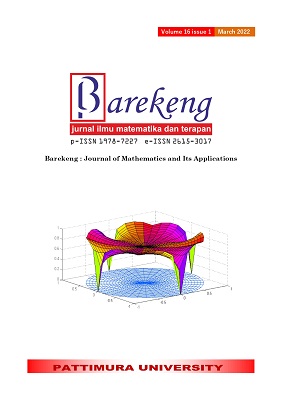IDENTIFICATION OF FACTORS IN SELECTING HIGH SCHOOL USING FACTOR ANALYSIS
Abstract
Parents want the best education for their children. Before starting the academic year, parents focus on finding the most suitable schools for their children. This study aimed to examine the factors affecting parents’ decision-making when selecting schools. A sample of 150 parents whose children are incoming high school students in 2020/2021 is involved in this study and selected using a snowball sampling technique and confirmatory factor analysis. This study has shown that the quality of the teachers is the factor that parents consider the most in their decision-making process. It is followed by the tuition and fee costs, the school facilities, and the school achievements.
Downloads
References
E. Kuswadi, “Peran Lingkungan Sekolah dalam Pengembangan Mental Siswa,” ["The Role of the School Environment in the Mental Development of Students,"] EL-BANAT: Jurnal Pemikiran dan Pendidikan Islam, Vols. Volume 9, nomor 1, pp. 64-78, 2019.
I. Nurkholis, Masrukhi & Juhadi , “Full-day School Application and Its Effect on Character Building of Students (Case Study at Elementary School Nasima Semarang),” Journal of Educational Social Studies. DOI, vol. 7 (2), p. 224 – 230, 2018.
I. S. F. H. Rr. H. Ervina, “Faktor-Faktor Yang Mempengaruhi Minat Orang Tua Dalam Memilih Sekolah Menengah Kejuruan Negeri 2 Semarang,” ["Factors Affecting Parents' Interest in Choosing State Vocational High School 2 Semarang,"] STABILITY Journal of Management & Business, vol. Vol 2, no. 1, pp. 1-13, 2019.
I.P. Lestari , A.Y. Sobri, & D. E. Kusumaningrum, “Analisis Faktor-Faktor Yang mempengaruhi Peserta Didik Dalam Pemilihan Sekolah Lanjutan Tingkat Atas,” ["Analysis of Factors Affecting Learners in the Selection of Senior High Schools,"] JAMP: Jurnal Adminitrasi dan Manajemen Pendidikan, vol. 2, no. 3, pp. 167-171, 2019.
N. P. D. Krismawintari, “Faktor-faktor Yang Dipertimbangkan Orang Tua Dalam Memilih Sekolah (Studi pada SMPK 1 Harapan Denpasar),” ["Factors that Parents Consider in Choosing a School (Study at SMPK 1 Harapan Denpasar),"] Jurnal Ekonomi dan Pariwisata, vol. 10, no. 2, pp. 31-44, 2016.
R.A. Johnson & D.W. Wichern, Applied Multivariate Statistical Analisis, New Jersey: Pearson Prentice Hall, 2014.
J. F. Hair Jr, W. C. Black,B. J. Babin, R. E. Anderson, Multivariate Data Analysis,Eighth Edition, Singapore: Cengage Learning EMEA, 2019.
S. Sharma, Applied Multivariate Techniques, New York: J Wiley, 1996.
T. Brown, Confirmatory factor Analysis for Applied Research, Second Edition, New York: Guilford Press, 2015.
J. W. Creswell, Research Design: Qualitative, Quantitative, and Mixed Methods Approaches, New Delhi: SAGE Publications. Inc., 2009.
M. Naderifar, H. Goli and F. Ghaljaie, “Snowball Sampling : A Purposeful Method of Sampling in Qualitative Research,” Strides in Development of Medical Education. DOI: 10.5812/sdme.67670, vol. 14, no. 3, pp. 1-7, 2007.
H. Taherdoost, “Sampling Methods in Research Methodology; How to Choose A Sampling Technique for Research,” International Journal of Academic Research in Management (IJARM), vol. 5, no. 2, pp. 18-27, 2016.
R. Heale & A.Twycross, “Validity and Reliability in Quantitative Studies,” Evid Based Nurs, vol. 18, no. 3, pp. 66-67, 2015.
H. Taherdoost, “Validity and Reliability of the Research Instrument;How to Test the Validation of a Questionnaire/Survey in a Research,” International Journal of Academic Research in Management (IJARM), vol. 5 , no. 3, pp. 28-36, 2016.
I. Gozali, Aplikasi Analisis Multivariate Dengan Program IBM SPSS 19 Edisi 5, Semarang: Badan Penerbit Universitas Diponegoro, 2011.
Authors who publish with this Journal agree to the following terms:
- Author retain copyright and grant the journal right of first publication with the work simultaneously licensed under a creative commons attribution license that allow others to share the work within an acknowledgement of the work’s authorship and initial publication of this journal.
- Authors are able to enter into separate, additional contractual arrangement for the non-exclusive distribution of the journal’s published version of the work (e.g. acknowledgement of its initial publication in this journal).
- Authors are permitted and encouraged to post their work online (e.g. in institutional repositories or on their websites) prior to and during the submission process, as it can lead to productive exchanges, as well as earlier and greater citation of published works.






1.gif)



